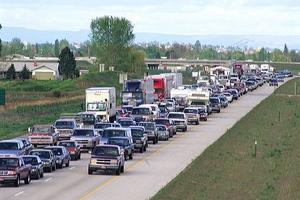Traffic
Speed Sells
MINNEAPOLIS–
Locals here have discovered something the auto makers have known for years–speed sells. Forget about pollution and energy consumption.
Like most big cities Minneapolis has the carpool “diamond lanes” on the freeways which are restricted to vehicles with two or more passengers including buses. Now, thanks to technology, they sell that lane to drivers who wish to go around the traffic snarls and slowpokes. First day reports indicate drive times are shaved in half.
With a credit card only you can get a little $40 transponder identifying you as one of the “go fast guys.” Monthly rental is $1.50 plus use fees. There are sensors along the road that monitor both traffic and those with transponders. Big fines if you cheat and the user fees range from 25 cents to $8 depending on traffic flow and time of day.
The Guardian thinks this would be great for Boise as well. Go fast from Caldwell to Boise for $8, make prohibited left turns for $5, run red lights for $1 each, drive in the bike lane for $3…what a way to raise much needed revenues to pay for the deficit at ICE WORLD!
To insure more advertising-free Boise Guardian news, please consider financial support.
 May 17, 2005
May 17, 2005 
Aug 5, 2005, 10:18 am
One policy response to the problem of congestion is to use the mechanism that works so well throughout the market economy: pricing. Congestion is considered an external cost (or “externality”) by economists. A motorist on a busy highway not only incurs a cost of delay but also imposes that cost on other motorists. Introducing congestion pricing on a crowded highway–that is, charging tolls that are higher during peak times of the day and lower during off-peak ones–has two economic effects. First, it dampens demand for the highway during the most congested periods by inducing some motorists to alter their travel plans. Some drivers will be able to modify their schedules so they use the road at less busy times. Others will find alternative routes or switch to public transit. Second, continued demand in the face of appropriate congestion pricing serves as a signal for additional investment in road capacity.